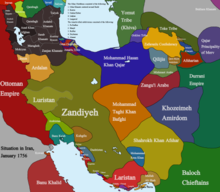Mohammad Hasan Khan Qajar


Mohammad Hasan Khan Qajar (Persian: محمدحسنخان قاجار), also spelled Muhammad and Hassan (1715–1759), chief of the Qoyunlu branch of the Qajar tribe of Turkomans in the Caspian coastlands around Astarabad,[1] was the son of Fath Ali Khan and the father of Agha Mohammad Khan Qajar, who founded the Qajar dynasty of Iran.
Mohammad Hasan Khan was driven from Astarabad in the early 1740s, but after the death of Nader Shah in 1747, he appears to have joined Shahrukh Afshar and was appointed beglerbeg of Astarabad and leader of all the nomadic groups in the province by Soleyman II; after the latter was deposed, Mohammad Hasan became virtually independent and extended his power to Mazandaran and Gilan.

After the khan of Tabriz, Azad Khan Afghan, attacked Mohammad Hasan Khan unsuccessfully, the latter counterattacked and ousted Azad Khan from Azerbaijan in 1757, taking Tabriz without a fight (being welcomed by its inhabitants, according to one account).[2] After an expedition to ensure the obedience of the khanates of the Caucasus, Mohammad Hasan Khan turned to face Karim Khan Zand; after some successes, penetrating as far south as Shiraz, Karim Khan's most dangerous rival was defeated and killed in Mazandaran in early 1759.[3]
References
- ^ Clifford Edmund Bosworth, The New Islamic Dynasties: A Chronological and Genealogical Manual (Columbia University Press, 1996: ISBN 0-231-10714-5), p. 285.
- ^ Christoph Werner, An Iranian Town in Transition: A Social and Economic History of the Elites of Tabriz, 1747-1848 (Otto Harrassowitz Verlag, 2000: ISBN 3-447-04309-1), p. 33.
- ^ Richard Tapper, Frontier Nomads of Iran: A Political and Social History of the Shahsevan (Cambridge University Press, 1997: ISBN 0-521-58336-5), p. 112.
Sources
- Perry, J. R. (1984). "ĀḠĀ MOḤAMMAD KHAN QĀJĀR". Encyclopaedia Iranica, Vol. I, Fasc. 6. pp. 602–605.
- Hambly, Gavin R.G (1991). "Agha Muhammad Khan and the establishment of the Qajar dynasty". The Cambridge History of Iran, Vol. 7: From Nadir Shah to the Islamic Republic. Cambridge: Cambridge University Press. pp. 104–144. ISBN 9780521200950.
